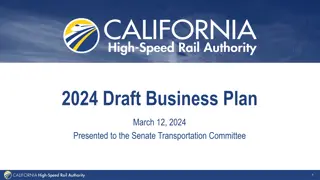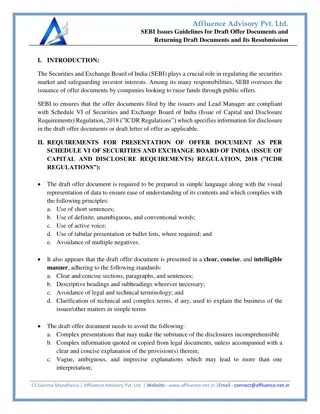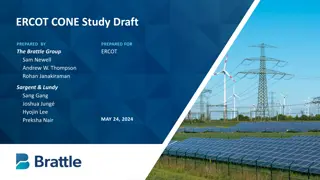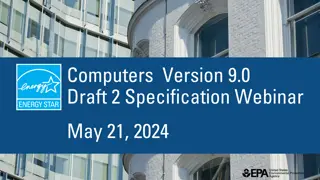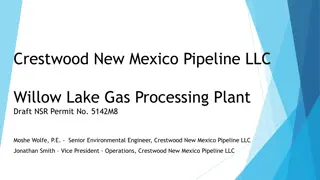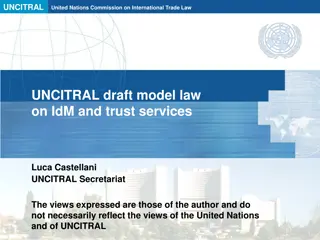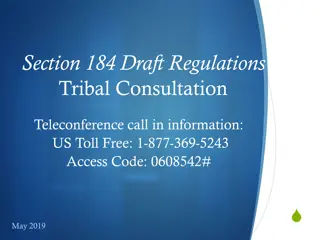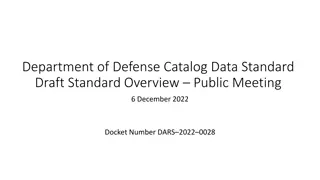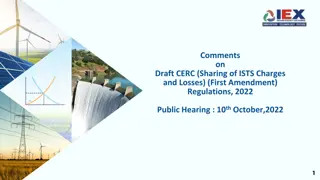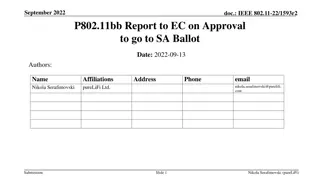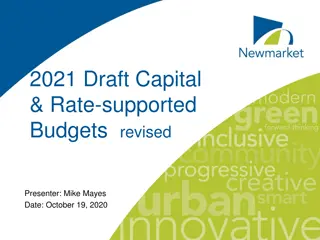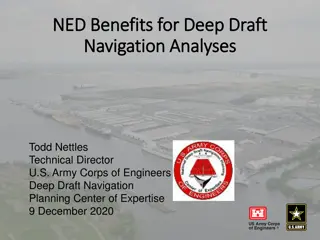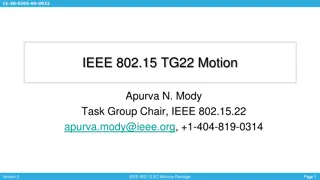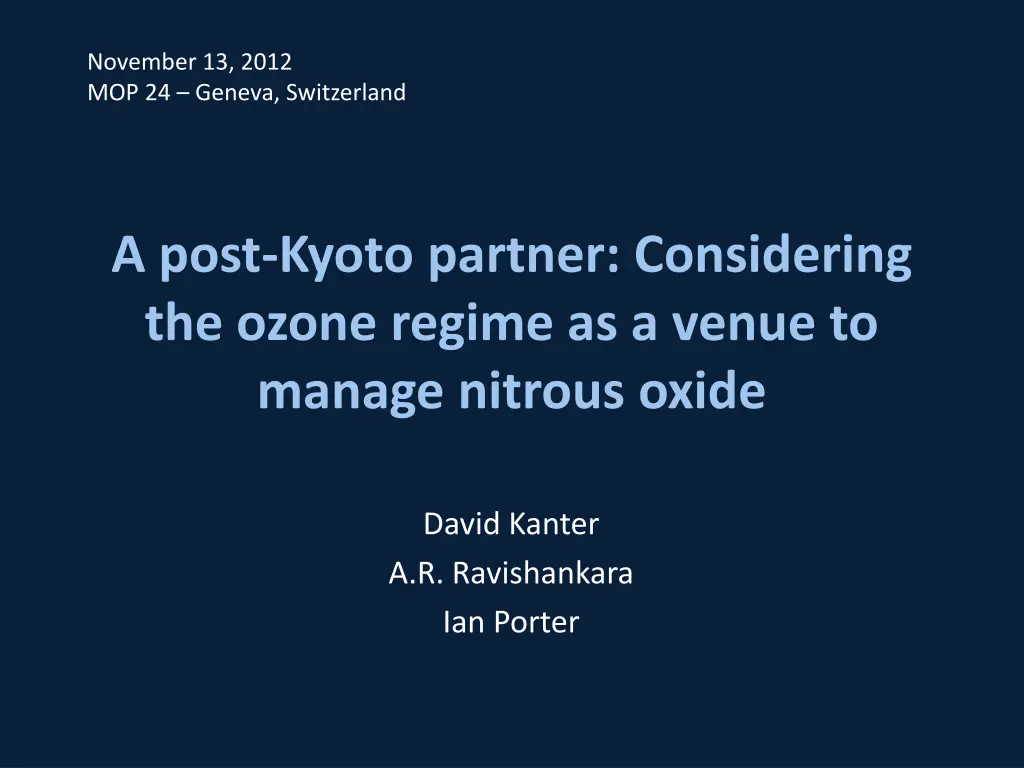
Managing Nitrous Oxide: Ozone Regime Analysis
Explore the potential decision by the Parties to address N2O emissions within the ozone regime in this in-depth paper. Learn about the Ozone Depletion Potential of N2O, its human-induced sources, current levels, and consequential impact on the environment. Understand the significant role of anthropogenic N2O emissions and the need for action to mitigate its effects in the 21st century.
Download Presentation

Please find below an Image/Link to download the presentation.
The content on the website is provided AS IS for your information and personal use only. It may not be sold, licensed, or shared on other websites without obtaining consent from the author. If you encounter any issues during the download, it is possible that the publisher has removed the file from their server.
You are allowed to download the files provided on this website for personal or commercial use, subject to the condition that they are used lawfully. All files are the property of their respective owners.
The content on the website is provided AS IS for your information and personal use only. It may not be sold, licensed, or shared on other websites without obtaining consent from the author.
E N D
Presentation Transcript
November 13, 2012 MOP 24 Geneva, Switzerland A post-Kyoto partner: Considering the ozone regime as a venue to manage nitrous oxide David Kanter A.R. Ravishankara Ian Porter
Outline Preview of forthcoming paper: A post-Kyoto partner: Considering the ozone regime as a venue to manage nitrous oxide under review at the Proceedings of the National Academy of Science Authors: David Kanter (Princeton), Denise Mauzerall (Princeton), A.R. Ravishankara (NOAA), John Daniel (NOAA), Bob Portmann (NOAA), Pete Grabiel, Bill Moomaw (Tufts), Jim Galloway (U. of Virginia) Paper goal: An objective examination of major scientific, legal, technical and policy issues surrounding a potential decision by the Parties to take on N2O
Ozone Depletion Potential of N2O ODP of N2O = 0.017 Compare 0.017 for N2O with: HCFC-123 = 0.02; HCFC-124 = 0.022; HCFC-225ca = 0.025; HCFC-225cb = 0.033 ODP depends on: amount of sulfate aerosol, chlorine, and T To our knowledge, this is the first time ODP of N2O was calculated as in the case of the Montreal Protocol gases 4 N2O side event_13Nov_2012. Geneva 2012
A significant part of N2O emission is of human origin Preindustrial level ~270 parts per billion (ppb) Increases in N2O is due to human activity Anthropogenic sources: agricultural fertilization, combustion, industrial production, etc. Current level ~325 ppb [N2O] increasing at ~0.25% (of total) per year; i.e., ~1% of anthropogenic component per year. N2O side event_13Nov_2012. Geneva 2012 5
Emissions, concentrations, and human- influenced contributions Anthropogenic 55 ppbv 6.7 TgN/yr 1 11 TgN/yr 1 270 ppbv 2 2 Current Emissions Current Atmospheric Concentrations Natural Large Natural Emissions Even larger natural concentrations- due to lifetime and previous emissions Anthropogenic concentrations growing rapidly Very similar to CO2! 6 N2O side event_13Nov_2012. Geneva 2012
ODP alone does not tell the story ODP-weighted emission of anthropogenic N2O ODP-weighted-emission of anthropogenic N2O was the fourth largest emission even in 1987, i.e., prior to the MP. Anthropogenic N2O is now the largest ozone depletion gas emission N2O s ODP is small- but its emissions are large If unabated, it will continues its growth in the 21st century; even the most optimistic projections shows an increasing N2O trend N2O side event_13Nov_2012. Geneva 2012 7
Ozone layer benefit of reducing a GHG 8 N2O side event_13Nov_2012. Geneva 2012
Summarizing N2O issues 1. N2O, when viewed as any other ozone-depleting substance (CFCs, Halons, methyl bromide, ), has an ODP of ~0.02. 2. ODP weighted emission of anthropogenic N2O is very large 3. Anthropogenic N2O is now the largest manmade ozone-depleting gas emission (a recent development owing to the successful abatement of CFCs and other ODSs under the Montreal Protocol!), and it will remain so for the next century if anthropogenic emissions of N2O are unabated. 4. Reductions in N2O emissions or stabilization of N2O will have climate and ozone layer benefits. N2O side event_13Nov_2012. Geneva 2012 9
Ozone regimes legal authority N2O is largest known remaining anthropogenic threat to stratospheric ozone layer (Ravishankara et al. 2009) Neither VC nor MP define ozone depleting substance for purposes of inclusion under ozone regime (Art. 1, MP & VC) N2O included in list of substances that modify the chemical and physical properties of the ozone layer under VC (Art. 3 & Annex I at (4)(b)) N2O could therefore be controlled under ozone regime
Legal pathways for N2Os inclusion Amendment to MP (Art. 2(10) MP) or new protocol under VC (Art. 2, 8 VC) Historical focus on regulating production and consumption could be useful for managing agricultural N2O emissions e.g. fertilizer efficiency standards
Interaction with current and post-2012 climate regime Establishing controls for N2O under ozone regime consistent with UNFCCC principles & ultimate objective (Article 2-3, UNFCCC). UNFCCC already delegates responsibility (aviation to ICAO, marine bunker fuels to IMO). Legal provisions could limit potential conflicts of authority (Grabiel & Roberts, 2010) Post-2012 climate regime in flux
Non-agricultural N2O mitigation Sector Percentage of total anthro. N2O emissions Technology and/or practice Mitigation potential Mitigation co- benefits Nitric & adipic acid Production <4% Catalytic reduction >90% NOx Biomass burning 8%-9% Conservation tillage, wildfire prevention education Highly variable CO2, CH4, CO, PM (2.5 & 10), black carbon, sulphates, NOx Stationary & mobile combustion 8%-14% Oxidation catalysts, catalytic reduction ~70%, ~80% respectively NOx References SEI (2010), IPCC (2006), EPA (2006), EPA (2012), Winiwarter (2005)
Agriculture - Behavior Fertilizer best management practices (Robertson & Vitousek 2009): Crop residue recycling & use of cover crops Precision & split fertilizer application Watershed management Livestock management 4Rs: Right product, right rate, right time, right place (IFA, 2007) Consumer behavioral changes food wastage, meat consumption
Agriculture - Technology Technology Mitigation potential Current use Mitigation co- benefits NO3-, NH3, NOx Nitrification inhibitors ~35% High value crops, ~12% US corn cropland NO3-, NH3, NOx Controlled-release fertilizer ~40% High value crops, <1% of US corn cropland NO3-, NH3, NOx Genetically engineered crops/breeding ~30% NA References Mosier et al. (2004), Akiyama et al. (2009), O Brien & Mullins (2009), Shrawat et al. (2008)
Nitrification inhibitors in action Ian Porter presentation
Existing policies - Direct Non-agricultural N2O: UNFCCC Kyoto Protocol EU Emissions Trading Scheme (ETS) US EPA/Dept. of Transportation Australia Carbon Tax & UK Climate Change Act Agricultural N2O: Alberta Quantification Protocol for Agricultural N2O Emissions Reductions (Canada) Carbon Farming Initiative (Australia) American Carbon Registry US Climate Action Reserve
Existing policies - Indirect Reactive N (indirect impact on N2O): Water Framework Directive (EU) NO3- Safe Drinking Water Act, Clean Water Act, Clean Air Act (USA) NO3-, NOx, NH3 Convention on Long Range Transport of Air Pollution (1988 Sofia Protocol, 1999 Gothenburg Protocol) NOx, NH3
Challenges & opportunities to managing agricultural N2O Food security How to preserve and increase crop yields while reducing N2O? Equity How to allow regions that vastly under-fertilize to increase fertilizer use while globally reducing N2O? Nitrogen cascade Tight coupling of N cycle means that one atom of nitrogen can cascade through a variety of chemical forms, each with a different impact on environment
Conclusions N2O largest remaining known anthropogenic threat to stratospheric ozone layer Ozone regime s legal authority and possibility of cooperation with climate regime clear Mitigation opportunities exist across all major sectors Challenges & opportunities exist for any international attempt to manage N2O Could mark welcome expansion of sustainable development diplomacy
Possible next steps Parties could request TEAP scoping report ( Task Force ) on technical & economic feasibility of specific N2O control strategies MLF could look to its experience with MeBr for general lessons on dealing with agricultural sector Implementation strategy could begin with point sources, then expand


